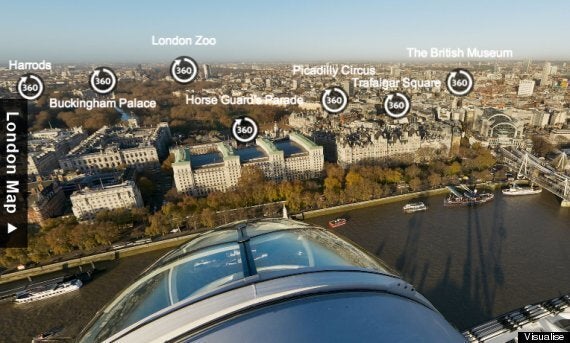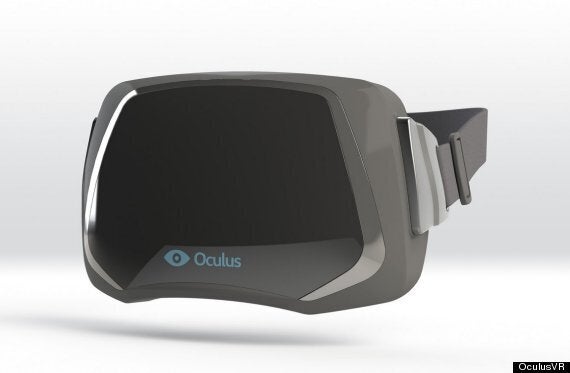Of the myriad possible uses for the next-gen of virtual reality, marketing might not seem like the most thrilling.
But if you take a trip down to the Visualise Studio in London for Social Media Week, you might come away with a different impression.
Visualise, the team behind some of the web's most impressive ultra-high 360-degree resolution images - from the London Olympics to the Queen's Jubilee - have unveiled some impressive new concepts for Oculus Rift-enabled imagery and advertising. And judging by our brief hands-on, their ideas should set brands' and marketers' minds racing for high-concept, and high tech, apps and experiences in the near future.

Henry Stuart, co-founder of Visualise, said that they are constantly looking for new ways to show off their work - and get brands interested in signing up to the (potentially…) hefty bandwidth costs involved in creating their captivating high-res images. Hence Oculus Rift. As we've explained elsewhere, the Oculus tech is rough around the edges, but already hugely immersive. It's an obvious choice for showing off 360 images - and inspiration for thinking about new ways of taking them, too.
The power of VR is simply the immediate impact it has - especially on people who are haven't tried it before.
"It's one of the most amazing things to try on people," Stuart said. "Nearly always when you show people new technology now they've seen it before - or they at least know about it… There's nothing I've seen before where you put it on someone and they might literally scream."
In person Visualise have a few demos to show. Our first hands (or rather eyes) on with the Oculus Rift was a tourism example, designed to help wearers explore London from their rooms (or a marketing pod in a shopping center or airport).
On the web it's a fine demo. On the Oculus? It's close to amazing.
We put on the goggles, and were transported straight to the top of the London Eye. We could look around the pod by moving our head, and the display responded immediately, letting us pick out details in the skyline in a very natural way. If we focused on a particular point of interest, the demo whizzed us straight into London for a 360 look around that landmark. Glance at the floor and we were back at the Eye, ready for another trip. Some of the landmarks - for instance, a boat in the middle of the Thames - incorporated 360-degree video too. Anyone who has used Google Street View is familiar with this type of imagery. And the resolution of the Rift doesn't allow you to view the amazing detail of the Gigapixel images to their full extent. But the immersion, the speed and the inventiveness of the experience is really impressive.
It's this kind of immersion with which Visualise are starting to experiment - taking their ultra-high res pictures and presenting them in a way that is more natural, and far more exhilarating, than has been possible before. Right now the low-res Oculus doesn't show their pictures off to the highest possible point - but there are ways around that too.
"One of the things we've been playing with is setting up a Kinect at the studio," Stuart said. "We can track people's movements so that when you've got the headset on, you can hold your hands up like binoculars and it zooms in to what you're looking at… It's incredibly intuitive."
"Sony are getting involved [in VR] too - I think a lot of people are going to jump into it. I don't think it's going to be as ubiquitous as other modern devices - phones or tablets. But I certainly think it will take off."

The next stage for Visualise would be to take these ideas, and make them even more immersive - whether for users at home with their own Rift sets, or for brands building custom experiences for theme parks or promotion.
Some possible high-level concepts include an NFL experience, where you wear the Rift and are transported into the role of quarterback. Your movements are tracked with sensors, like in any motion control game, but your view is a 360-degree, HD video view that of a real quarterback - 90,000 screaming fans, rushing Defensive Ends and all.
F1, football, journalism - all could have obvious, but hugely interesting and for Visualise potentially lucrative applications.
The potential opportunity for brands, especially when VR content is still thin on the ground, is significant too. Remember when most of the truly innovative iPhone apps seemed to be made by beer and shopping companies? That was not a coincidence.
"The next frontier is to have a camera which can instantly capture much more," Stuart said. "We're trying to work with companies to develop a 360 camera which is much better than what we have now."
Visualise are just one player in what could be a huge market. But their clearly full of ideas. We might still be a couple of hardware generations, and years, from truly mind-blowing VR . But with any luck they're one example of a company who could give you some mind-blowing images to look at on day one when your personal Rift finally arrives.